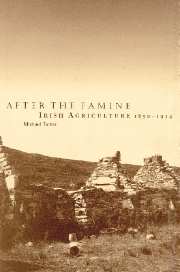Book contents
- Frontmatter
- Contents
- List of figures
- List of tables
- Preface and acknowledgements
- 1 Introduction: Ireland and Irish agricultural history in context
- 2 Agricultural change
- 3 The occupation of the land
- 4 The product of the land: output
- 5 The performance of agriculture
- 6 Labour and the working of the land
- 7 Conclusion – structure, output and performance, and the distribution of the spoils
- Appendixes: A note on the origin of the data
- Appendix 1 Annual agricultural statistics, 1847–1914
- Appendix 2 Crop yields in Ireland, 1847–1914
- Appendix 3 Landholding and land occupancy distribution, 1847–1914
- Appendix 4 Irish agricultural prices
- Appendix 5 Weighting procedures adopted in estimating agricultural output
- Appendix 6 Richard Barrington of Fassaroe, County Wicklow
- Bibliography
- Index
7 - Conclusion – structure, output and performance, and the distribution of the spoils
Published online by Cambridge University Press: 09 November 2009
- Frontmatter
- Contents
- List of figures
- List of tables
- Preface and acknowledgements
- 1 Introduction: Ireland and Irish agricultural history in context
- 2 Agricultural change
- 3 The occupation of the land
- 4 The product of the land: output
- 5 The performance of agriculture
- 6 Labour and the working of the land
- 7 Conclusion – structure, output and performance, and the distribution of the spoils
- Appendixes: A note on the origin of the data
- Appendix 1 Annual agricultural statistics, 1847–1914
- Appendix 2 Crop yields in Ireland, 1847–1914
- Appendix 3 Landholding and land occupancy distribution, 1847–1914
- Appendix 4 Irish agricultural prices
- Appendix 5 Weighting procedures adopted in estimating agricultural output
- Appendix 6 Richard Barrington of Fassaroe, County Wicklow
- Bibliography
- Index
Summary
Introduction
This study has endeavoured to explore the ways that the Irish agricultural economy responded to the various changes in the internal and external economic circumstances which confronted it in the second half of the nineteenth century and the first decade or so of the twentieth century. In isolation from the international world, and solely in comparison with the rest of the UK, the Irish agricultural industry seemed to respond positively to economic stimuli, and looked in an increasingly healthier position than its larger neighbour across the Irish Sea. When the comparisons were widened to embrace countries on the European mainland some of that initial enthusiasm for the Irish performance could still be maintained, though in a diluted form, but in specific comparison with some of the leading Western European economies the light which appeared to emanate from the Irish industry dimmed considerably. The models which have been used in the central chapters above were related to considerations of gross agricultural income and physical output.
In this final chapter of conclusions we pose what has become a fundamental question in nineteenth-century Irish economic history: to whose benefit did the structural changes in Irish agriculture accrue? Was it a question of a drain of benefits back to the colonial master? Of course not. Instead, after the Famine, slowly perhaps but inexorably, colonialism as a force of economic power (as distinct from a political reality) was turned on its head. Much of Ireland earned its economic independence by 1914, and soon afterwards full political independence followed.
Information
- Type
- Chapter
- Information
- After the FamineIrish Agriculture, 1850–1914, pp. 196 - 216Publisher: Cambridge University PressPrint publication year: 1996
